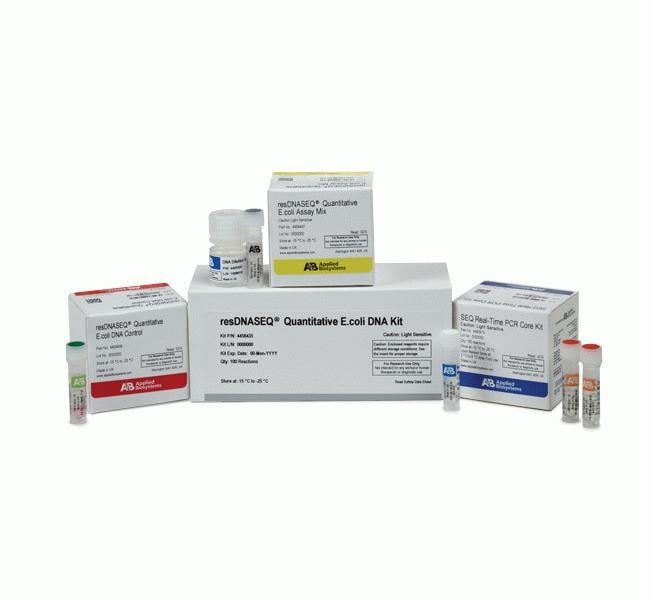Search Thermo Fisher Scientific

resDNASEQ™ Quantitative E. coli DNA Kits
| 카탈로그 번호 | 포함 |
|---|---|
| 4458435 | Assay Kit only |
| 4460366 | Assay Kit and Sample Preparation |
Features of the resDNASEQ Quantitative E. coli DNA Kit include:
• Highly sensitive quantitation using proven TaqMan™ real-time qPCR technology
• Manual and automated sample preparation, optimized for quantitative recovery from complex sample matrices (Table 1)
• Consistent performance across the expected range of DNA fragment sizes
• Integrated system from sample to results with sample preparation, master mix, TaqMan™ primer/probe mix, and genomic DNA standard
This kit is available with or without sample preparation reagents in the form of a PrepSEQ™ Residual DNA Sample Preparation Kit, which is optimized for highly efficient residual DNA recovery from complex mixtures of proteins, buffers, and salts.
Rapid, Sensitive Detection of E.Coli DNA
The resDNASEQ™ E. coli Residual DNA Quantitation System is a quantitative PCR (qPCR)-based system for the detection of host cell DNA from E. coli, an expression system commonly used for the production of recombinant proteins. Reliable and rapid, the system enables sensitive (LOQ = 15 pg DNA/mL test sample) and specific quantitation of E. coli DNA, typically in less than 4 hours. This performance helps ensure a high degree of confidence in quantitation data obtained from a broad range of sample types—from in-process samples to bulk drug substances—whether a sample contains high molecular weight or sheared DNA.
Table 1. DNA recovery using manual PrepSEQ™ sample preparation protocol.
Assay performance data using 10 pg E. coli genomic DNA spike per sample, 3 analysts, and 9 test samples.
| 50 mg/mL protein sample | ||
| Mean Recovery | Mean %CV | |
| E. coli | 83% | 5.04% |
• E.coli DNA Control, 30 ng/μL, 40 μL, store at –15 to –25°C
• DNA Dilution Buffer (DDB), 7 mL, store at –15 to –25°C before first use and 2−8°C after first use
resDNASEQ E.coli DNA Real-Time PCR Reagents
• Environmental Master Mix (2X), 2 x 0.75 mL, store at –15 to –25°C before first use and 2−8°C after first use, protect from light
• E.coli DNA Assay Mix (10X), 300 μL, store at –15 to –25°C, protect from light
• Negative Control (water), 1.0 mL, store at –15 to –25°C before first use and 2−8°C after first use